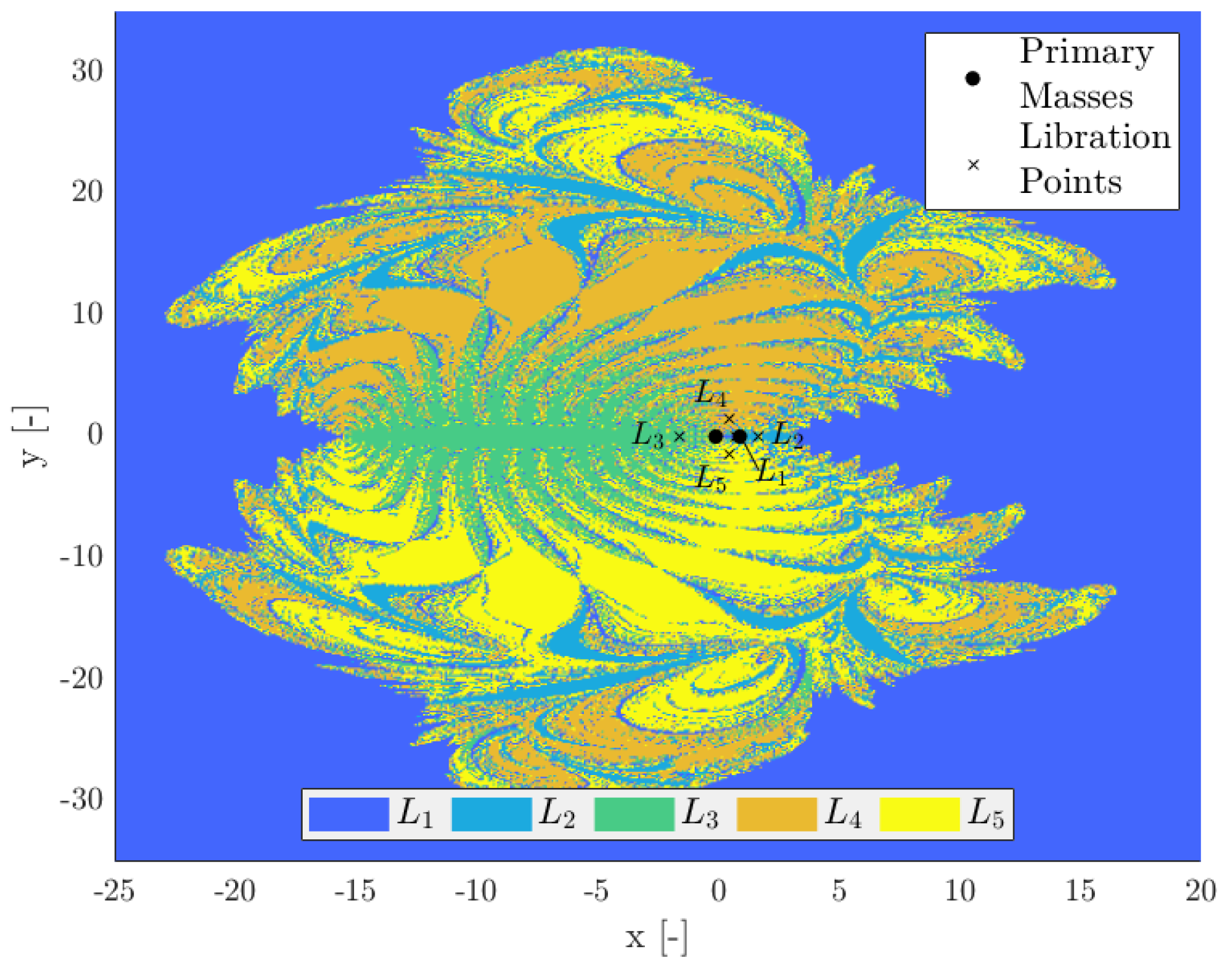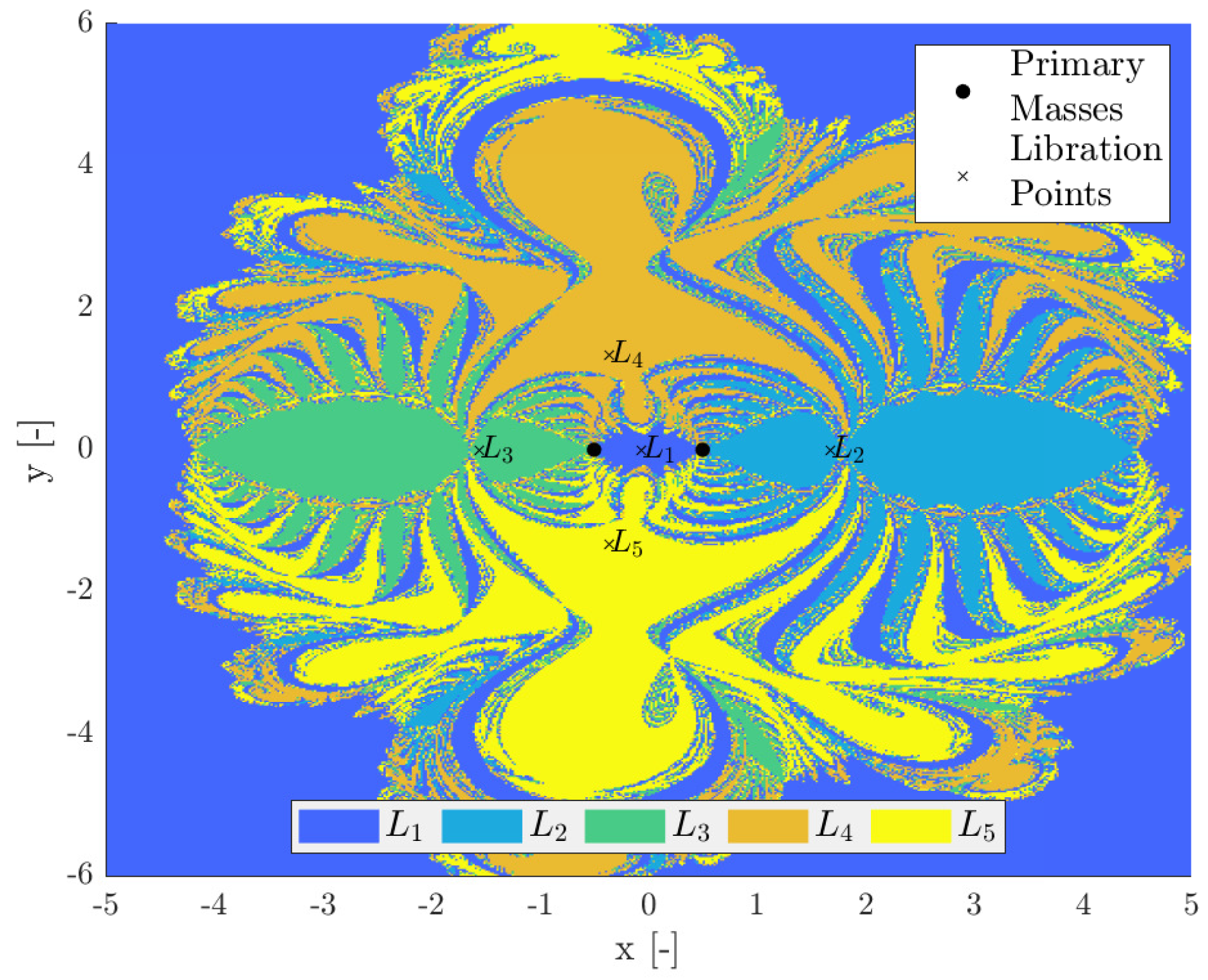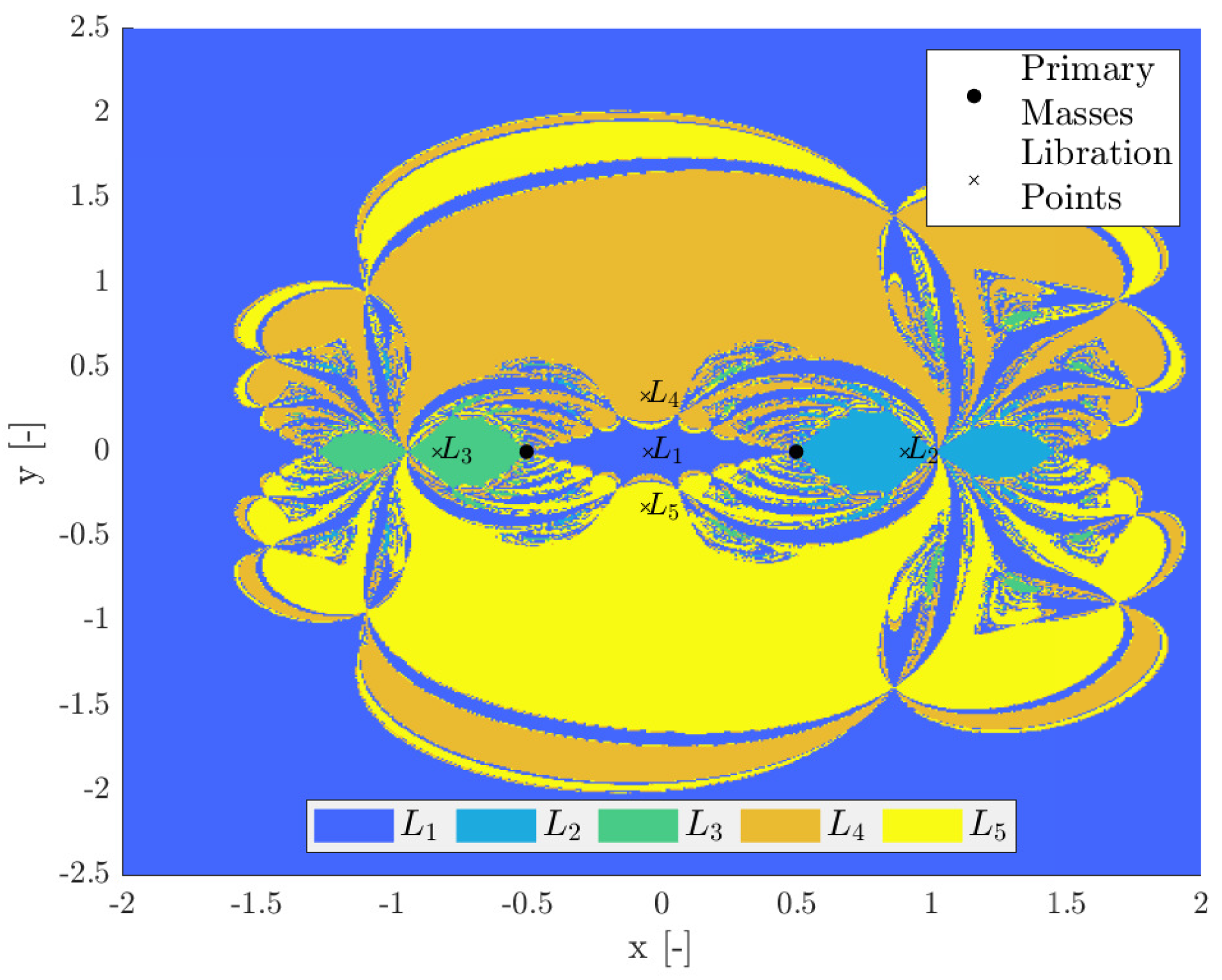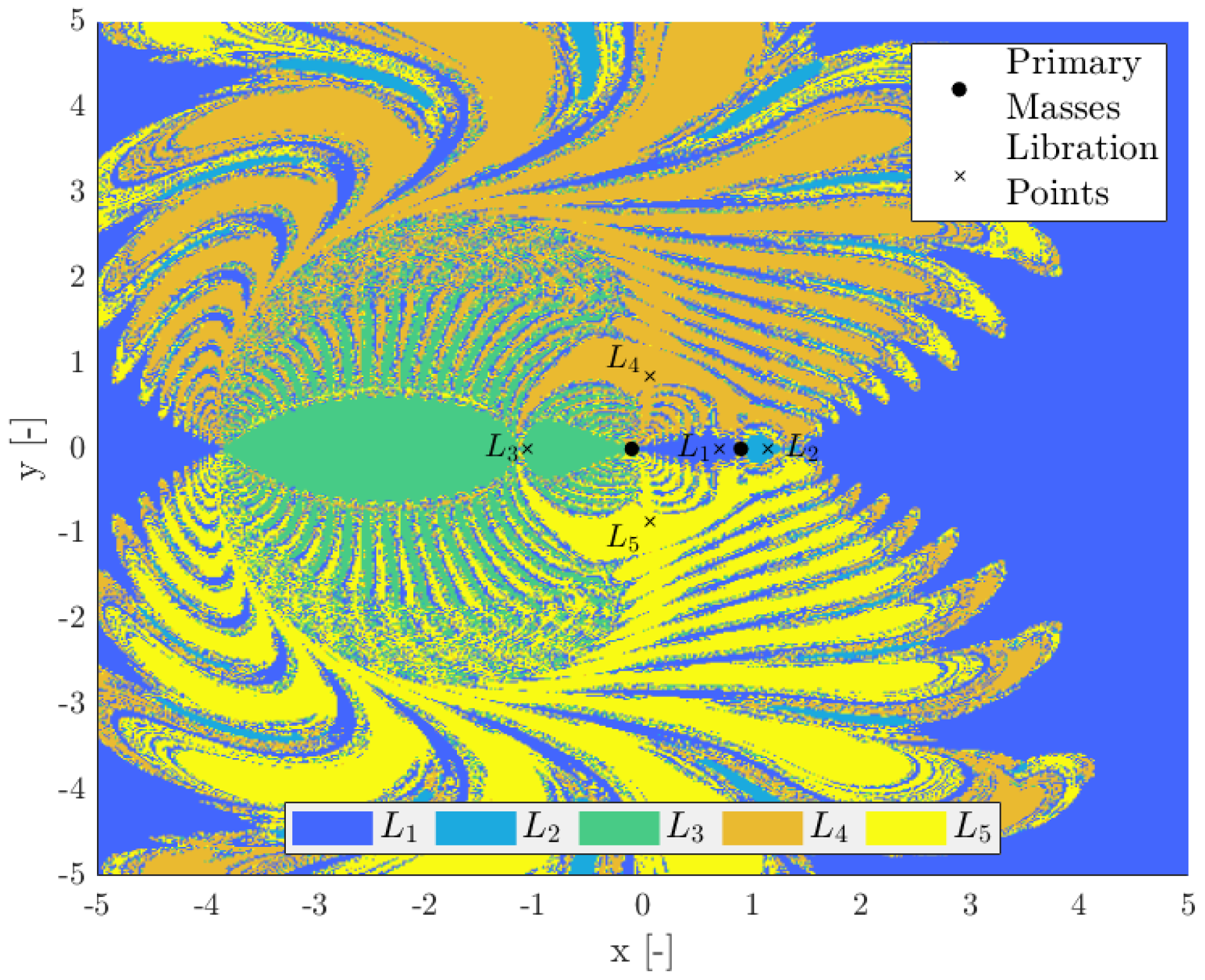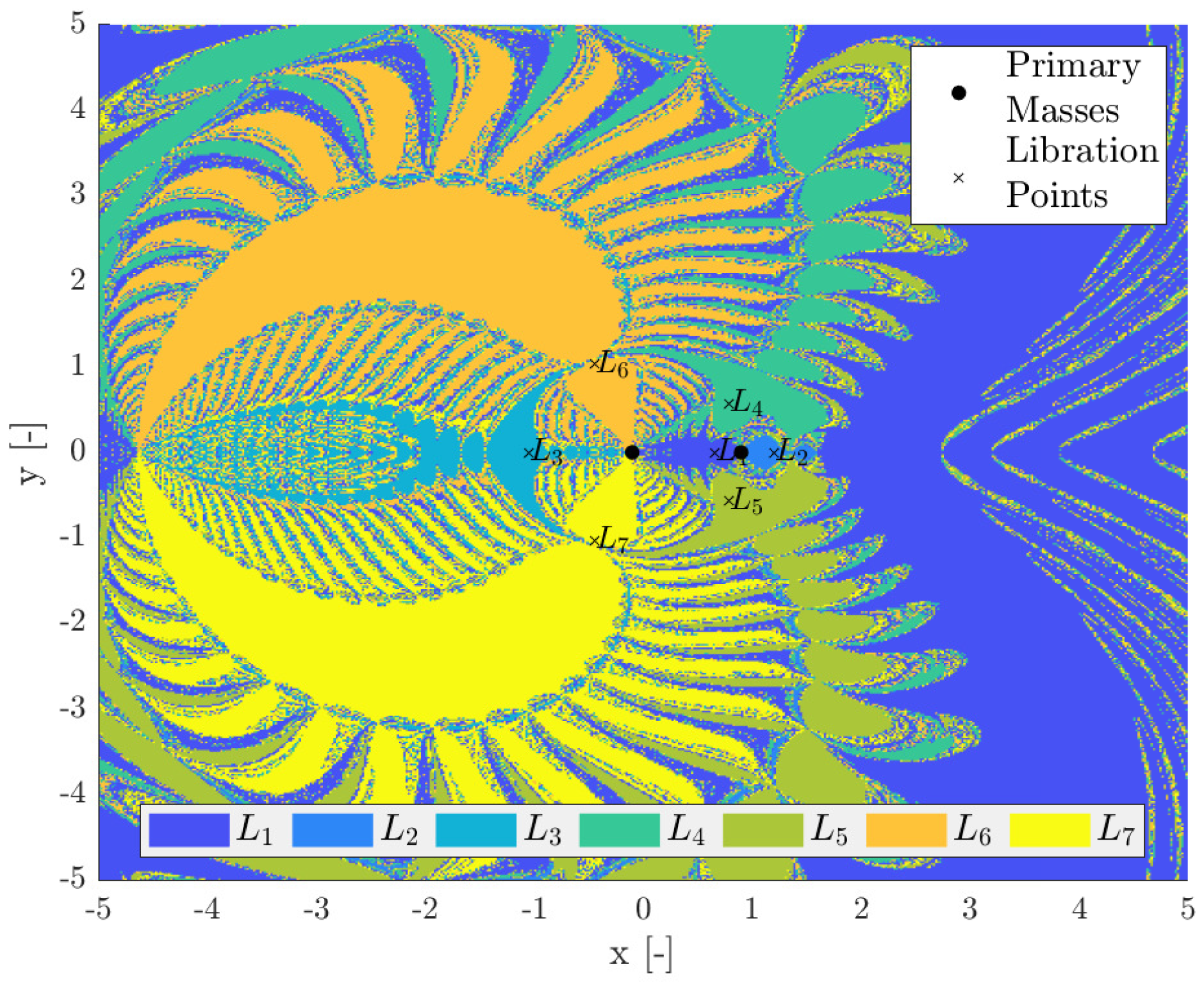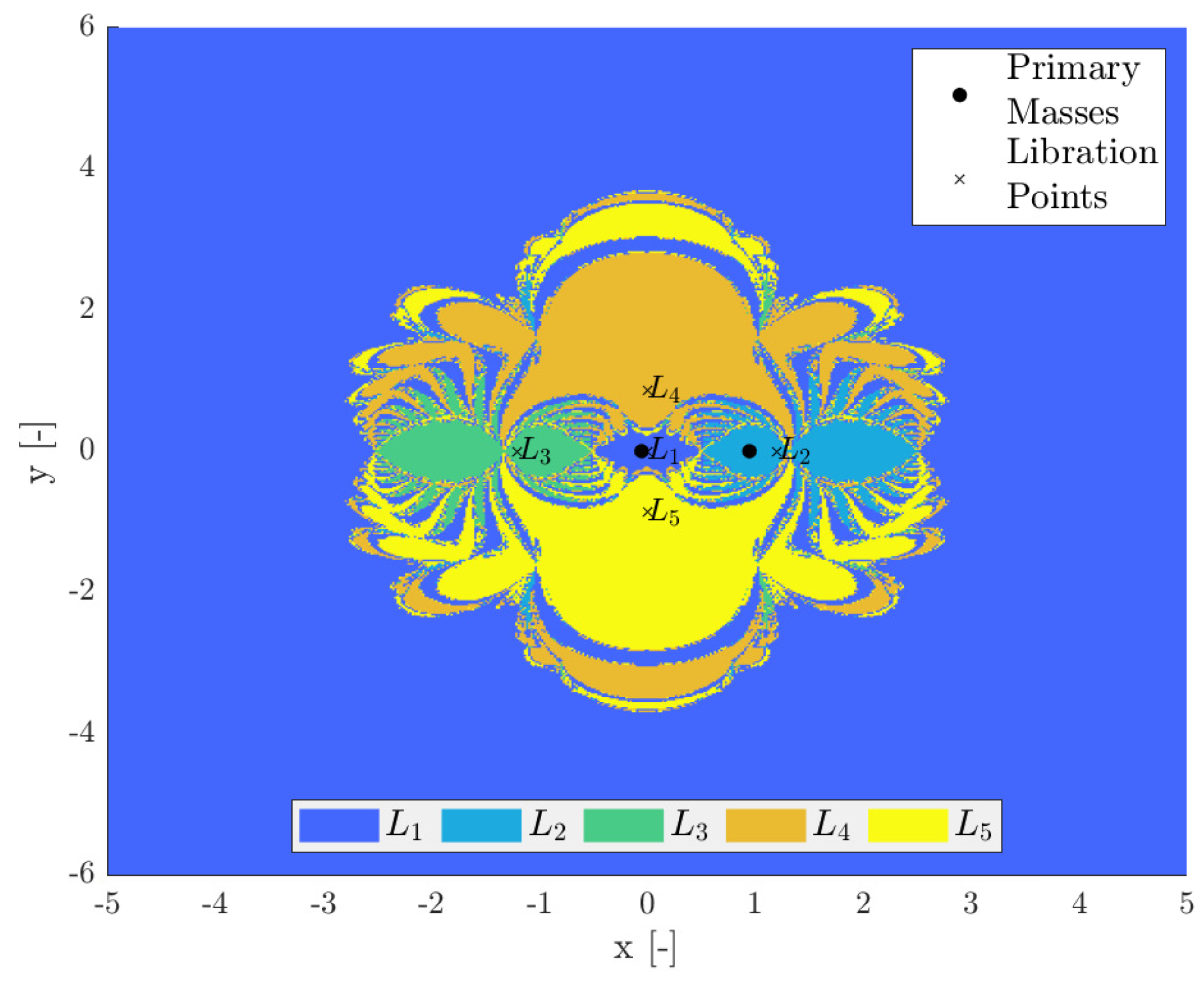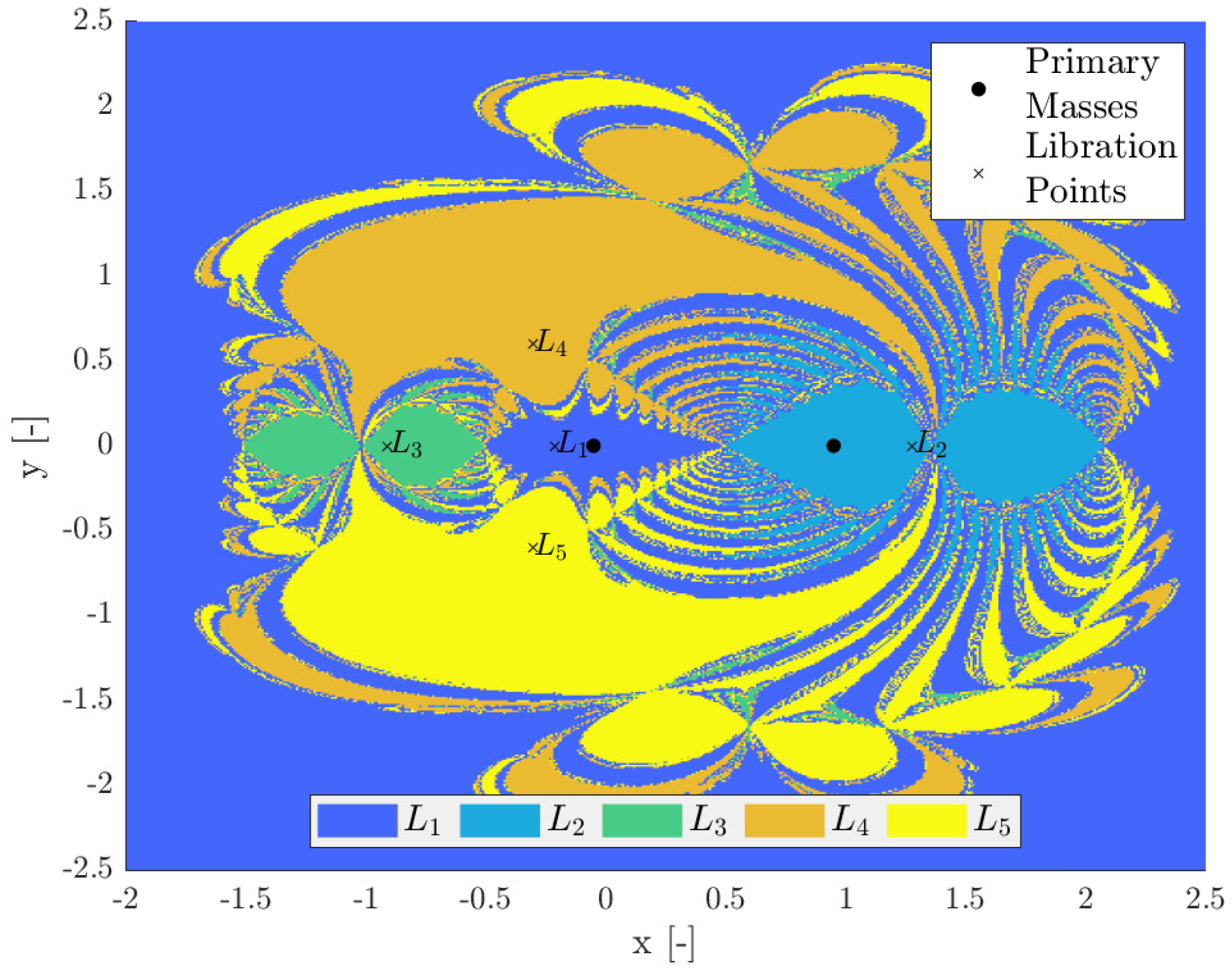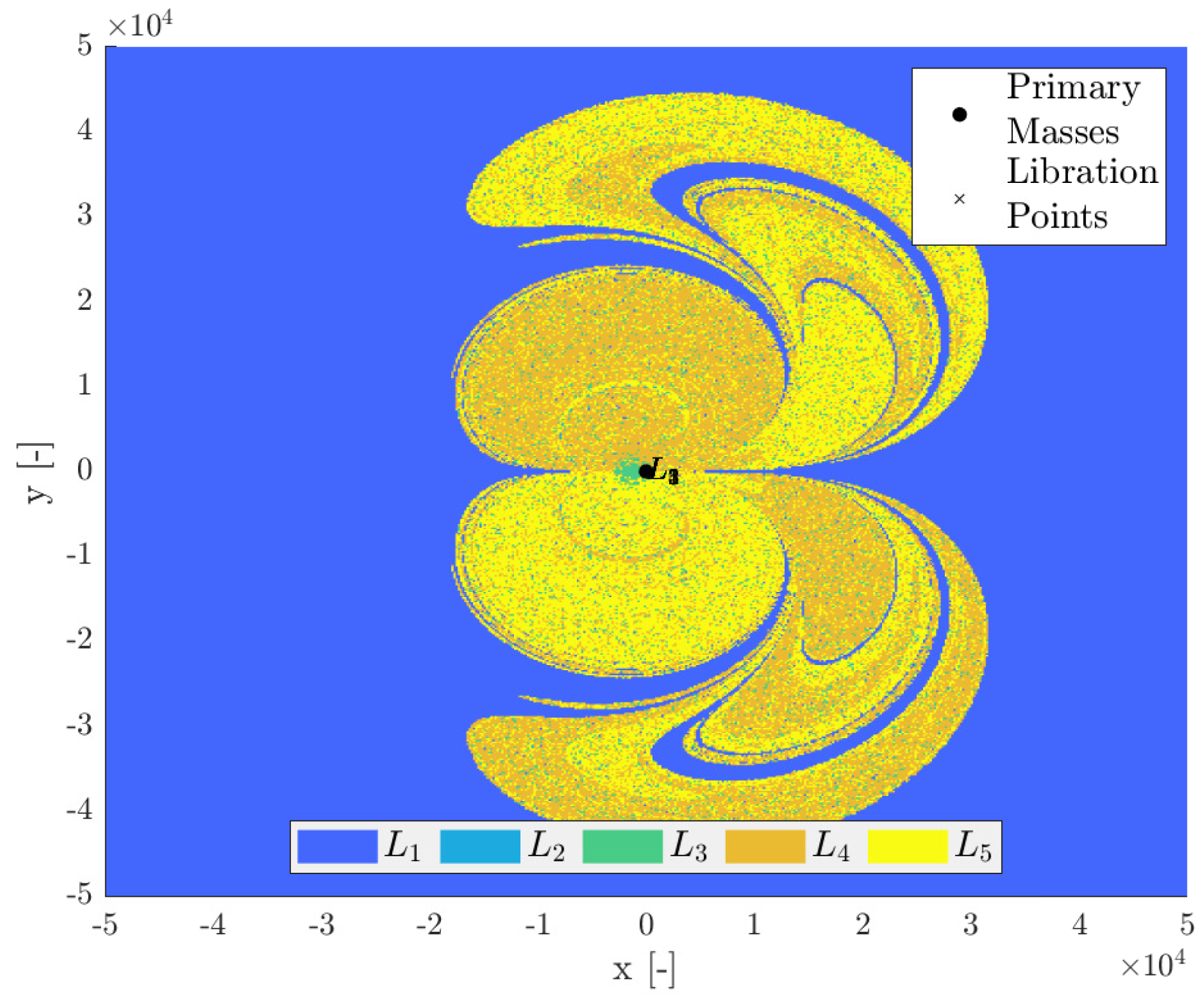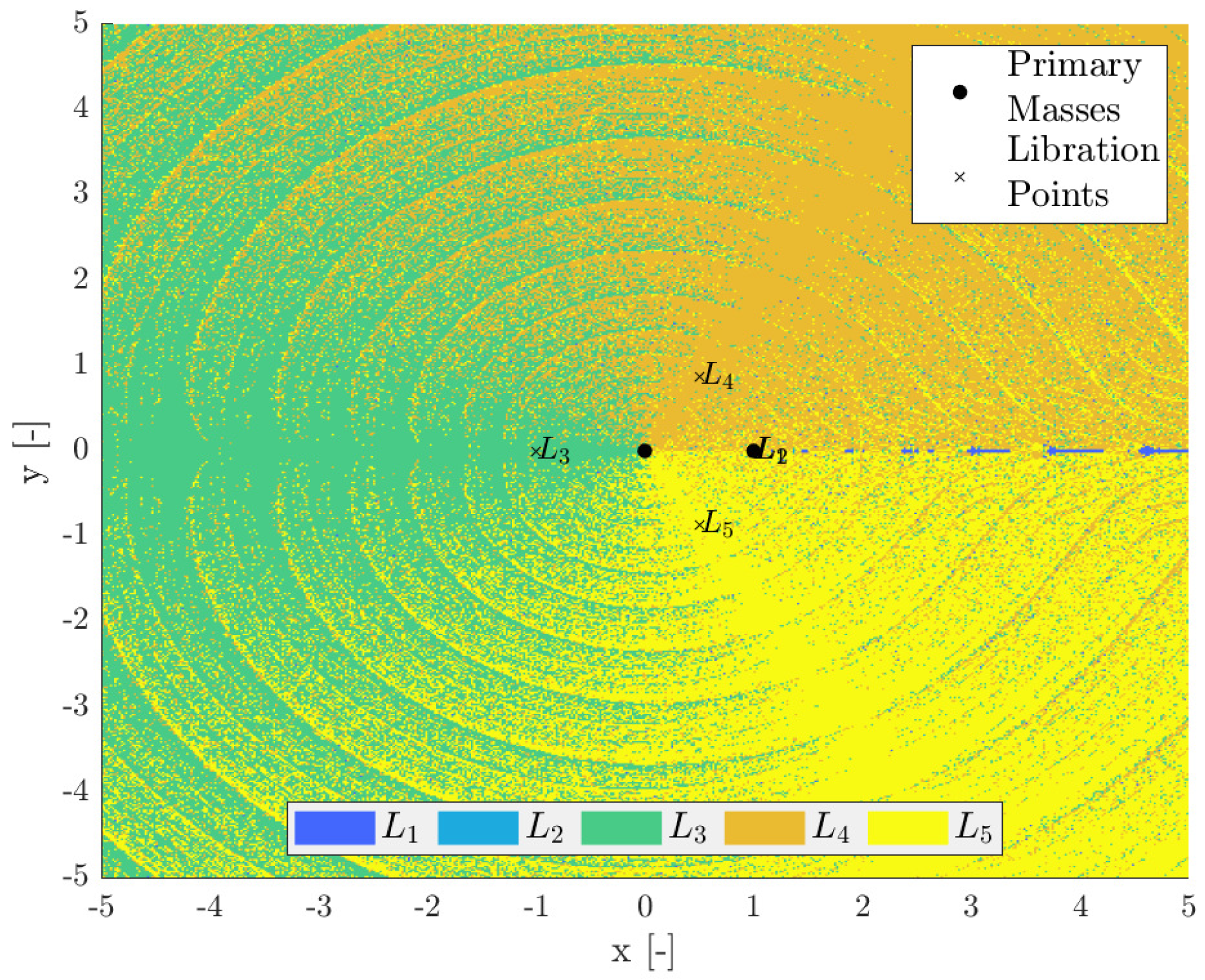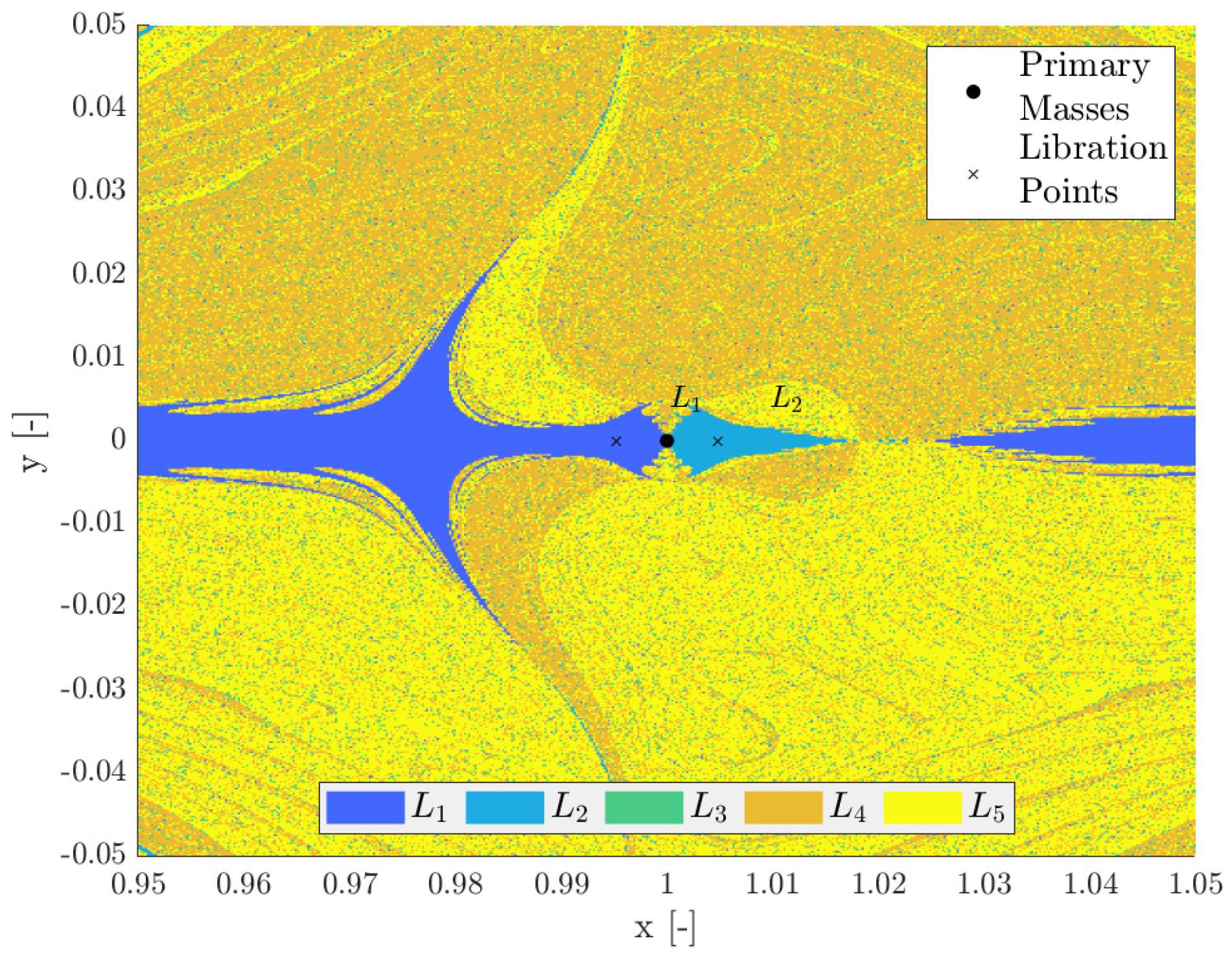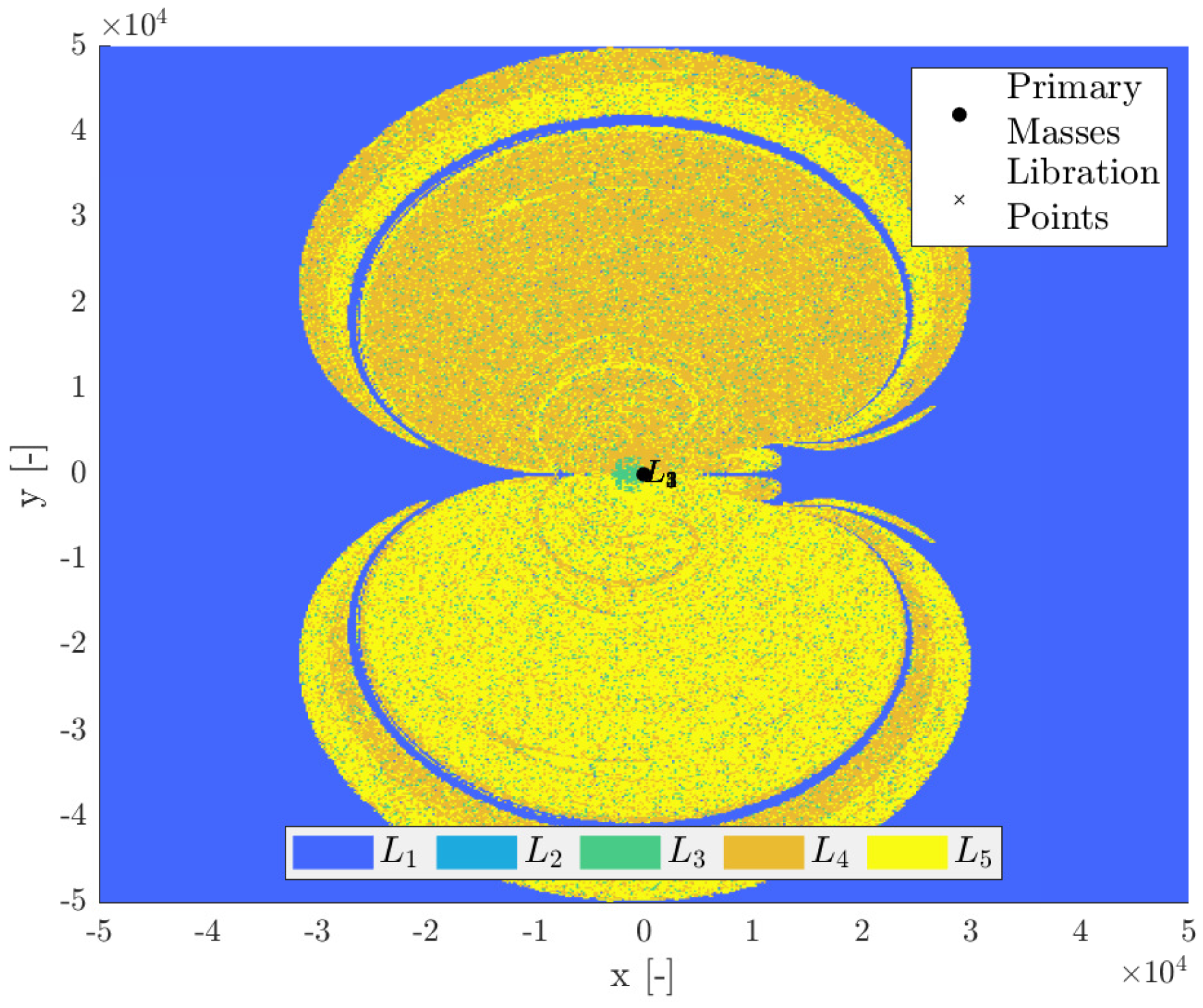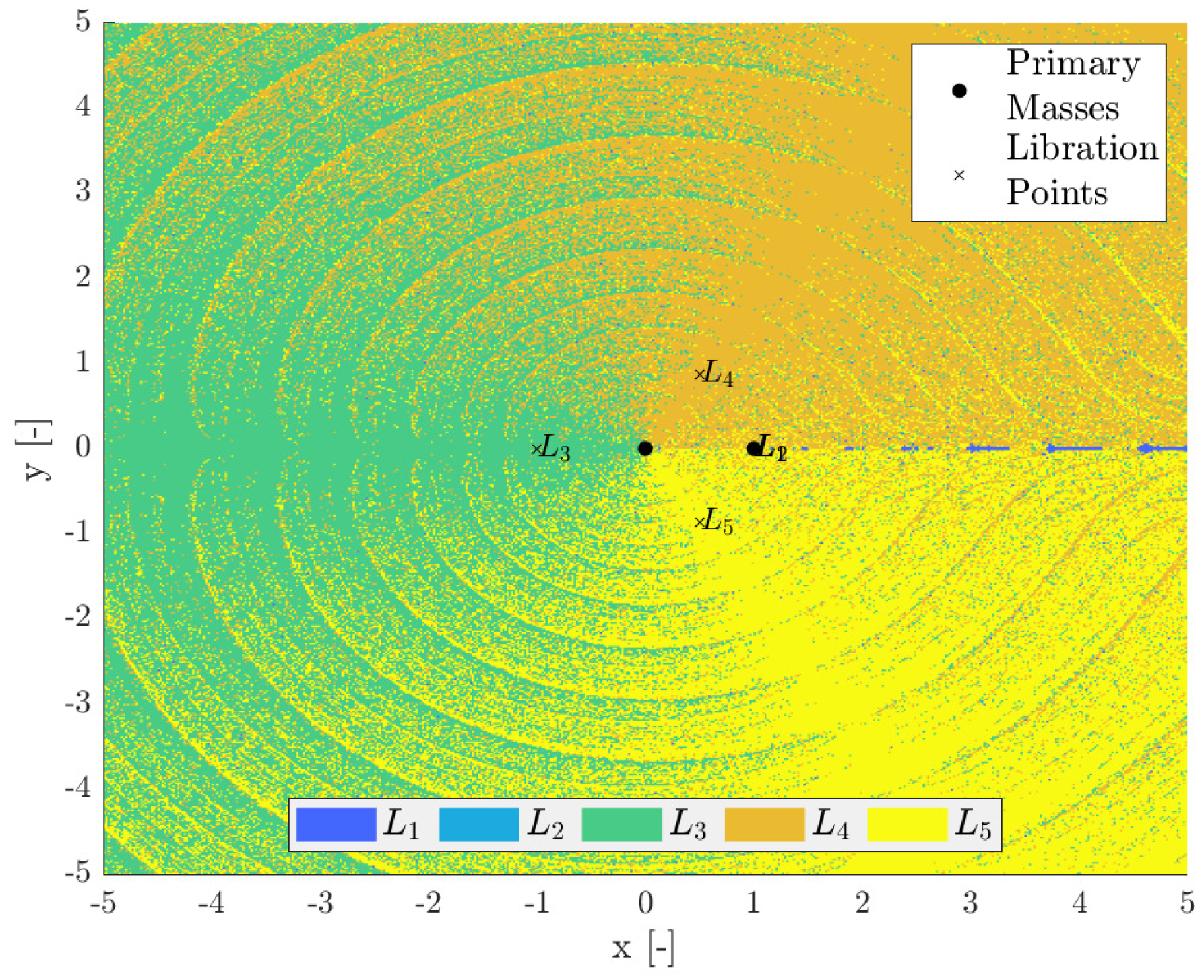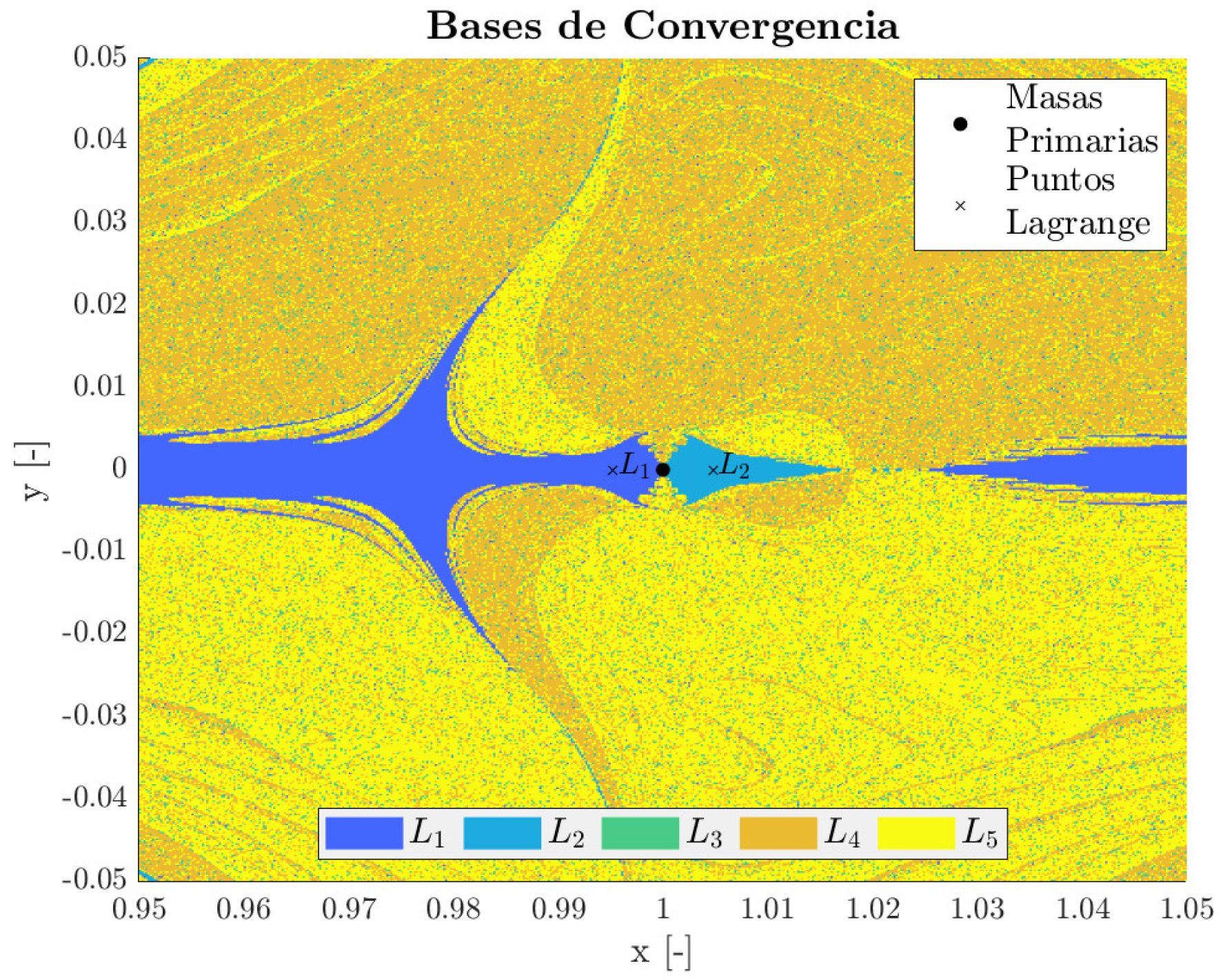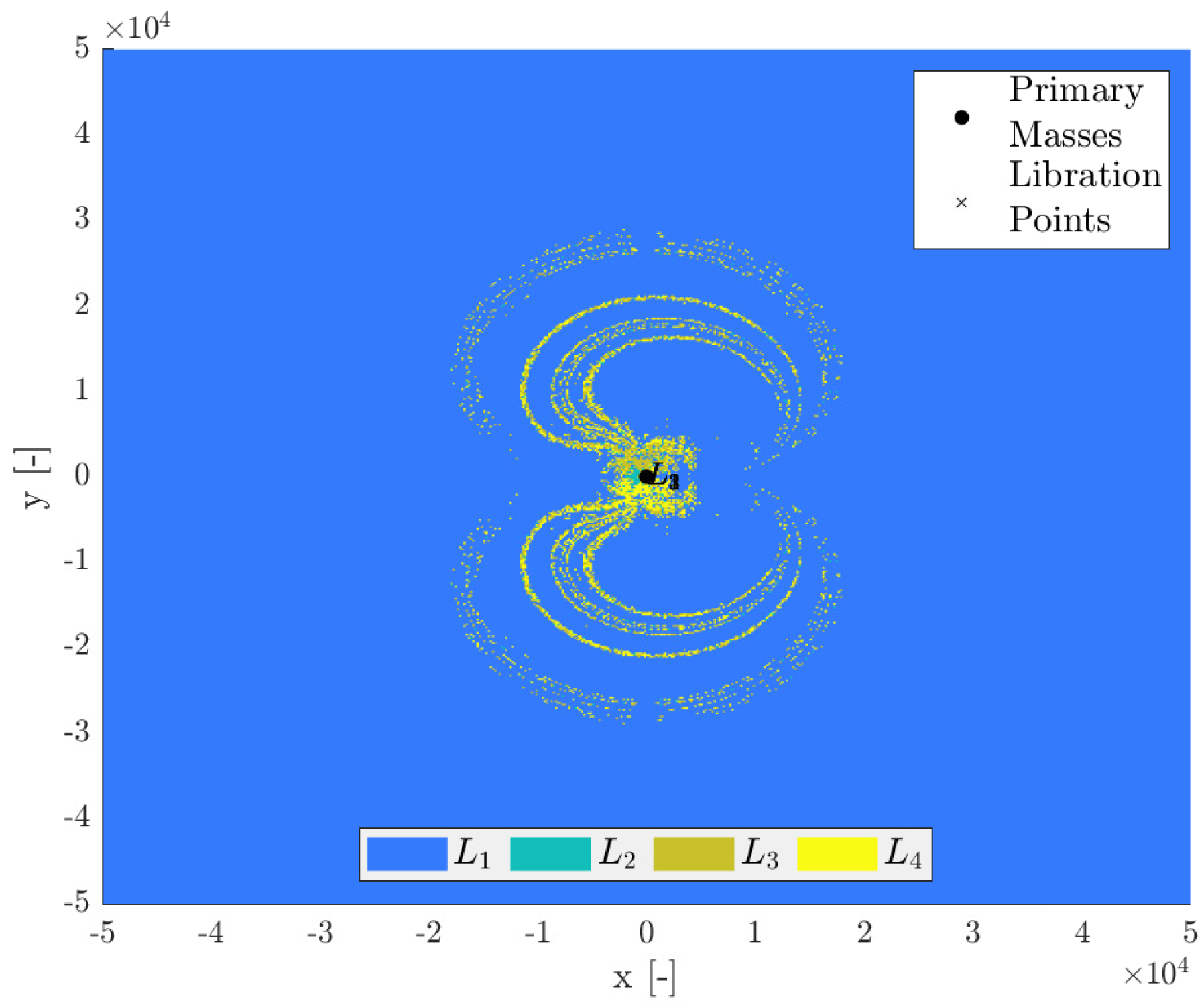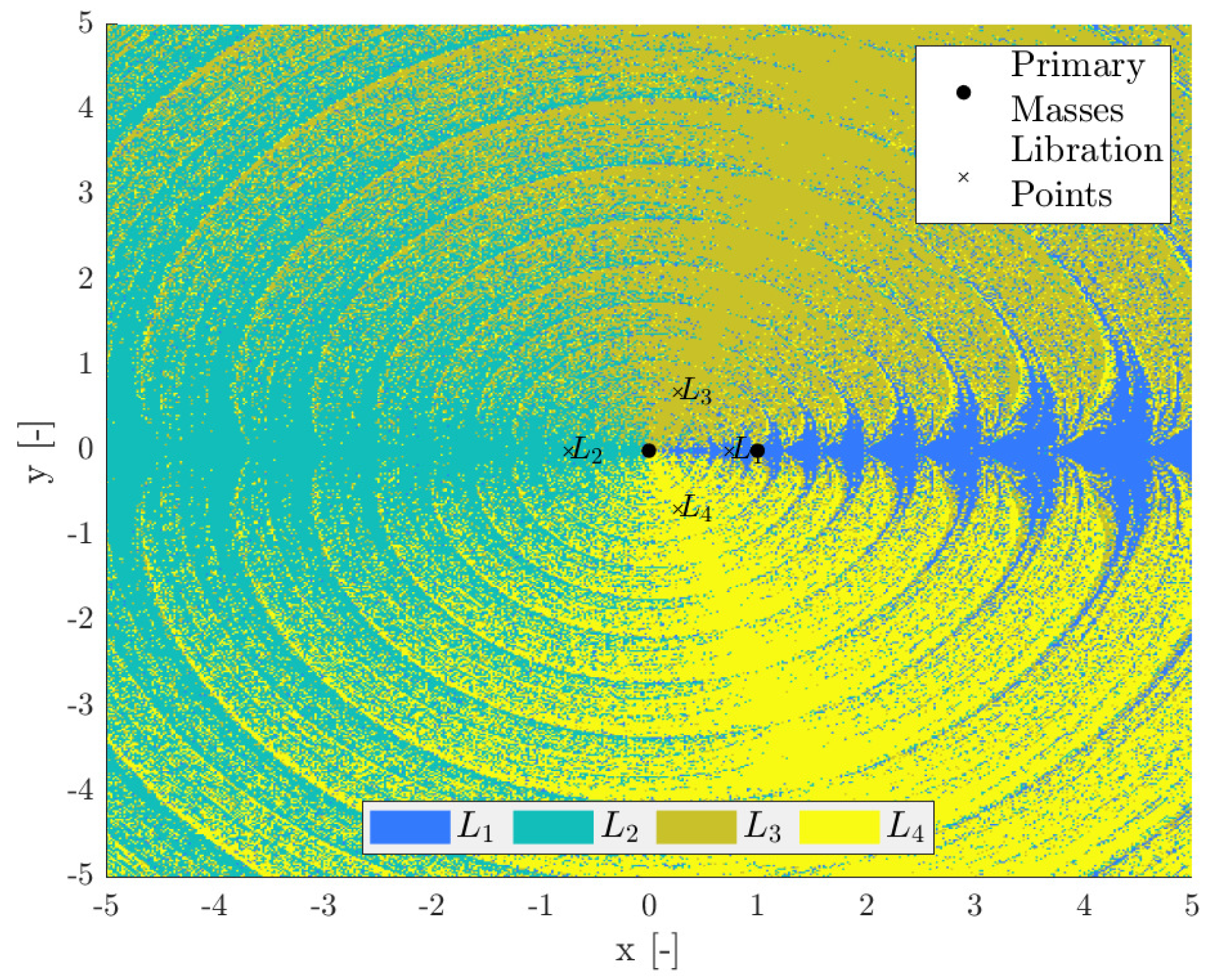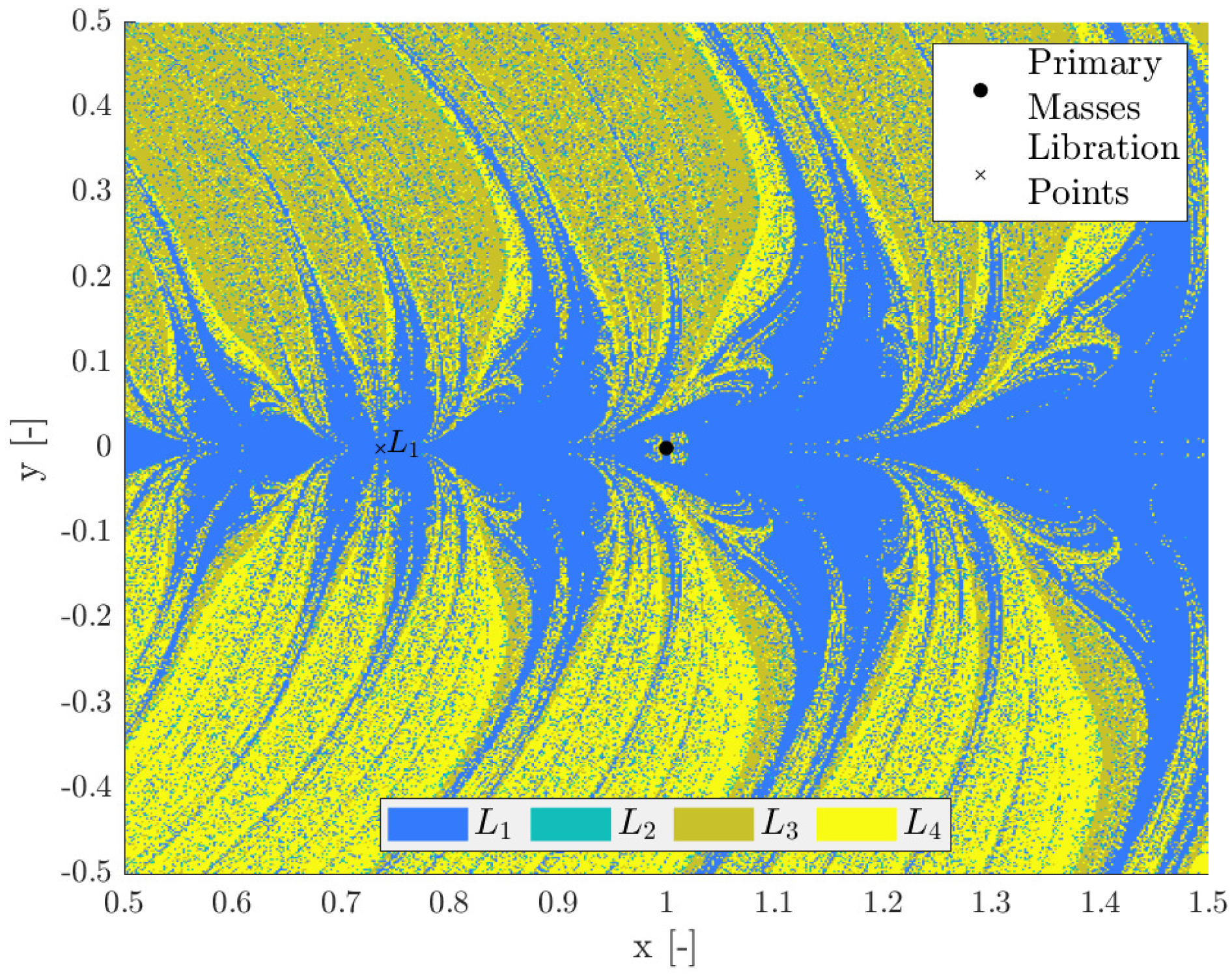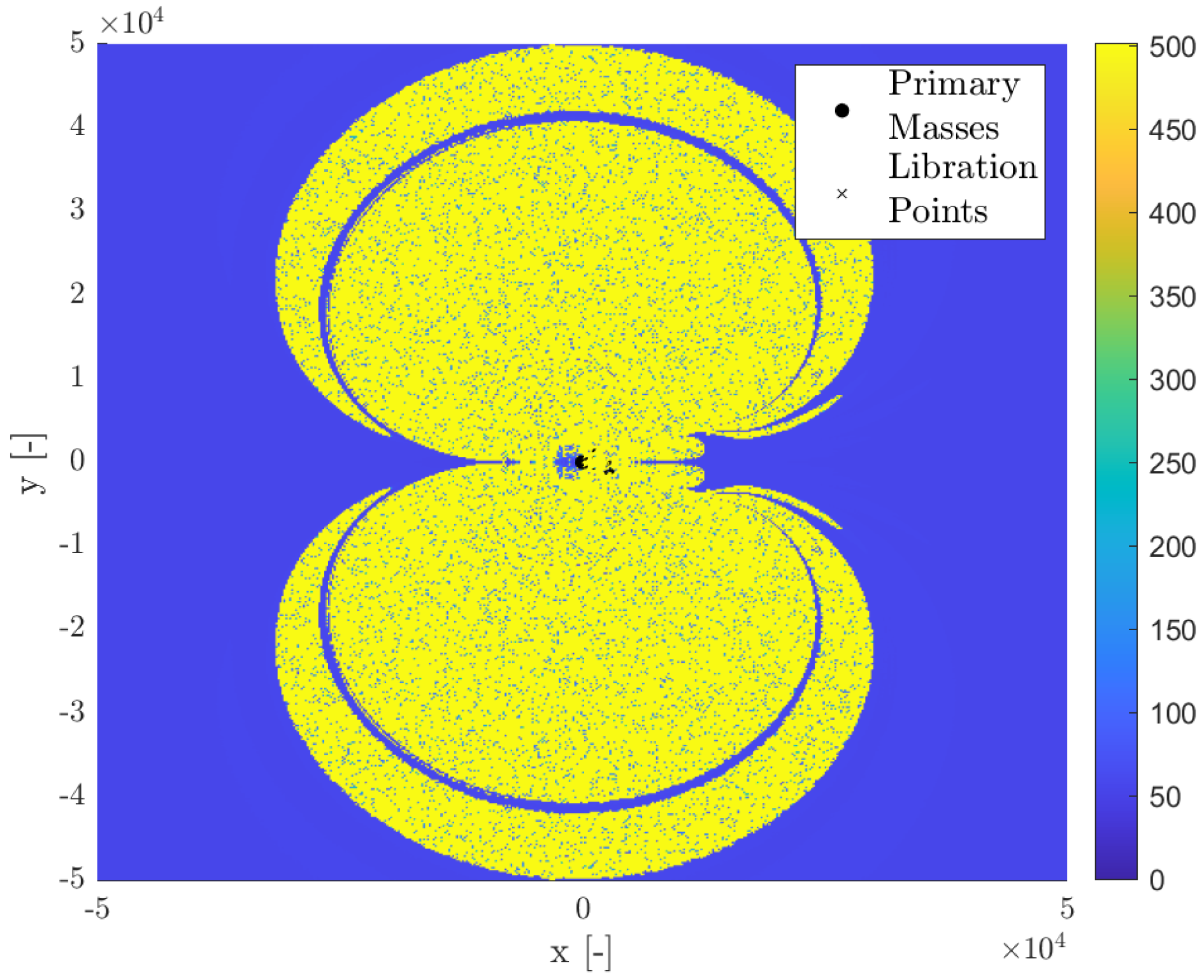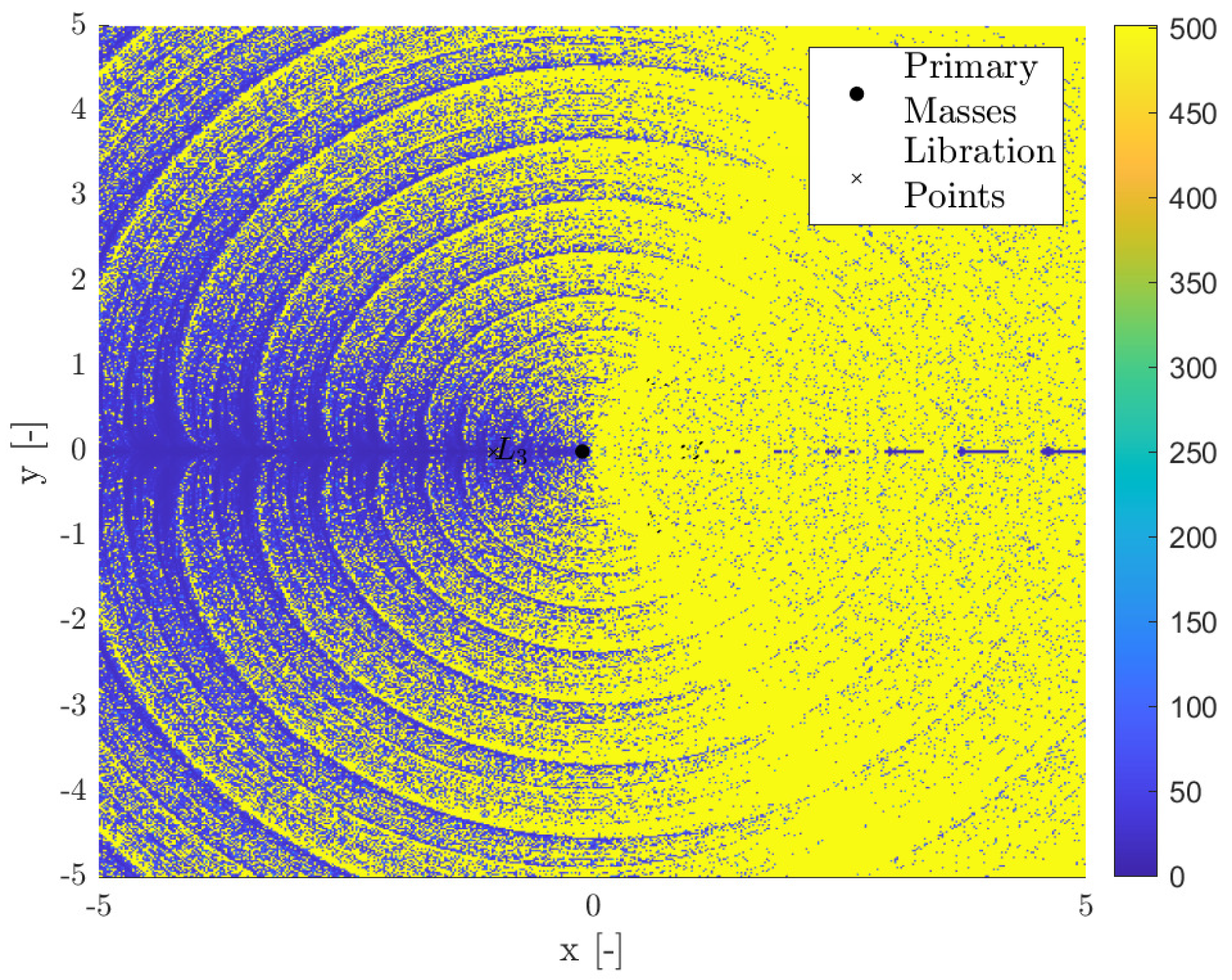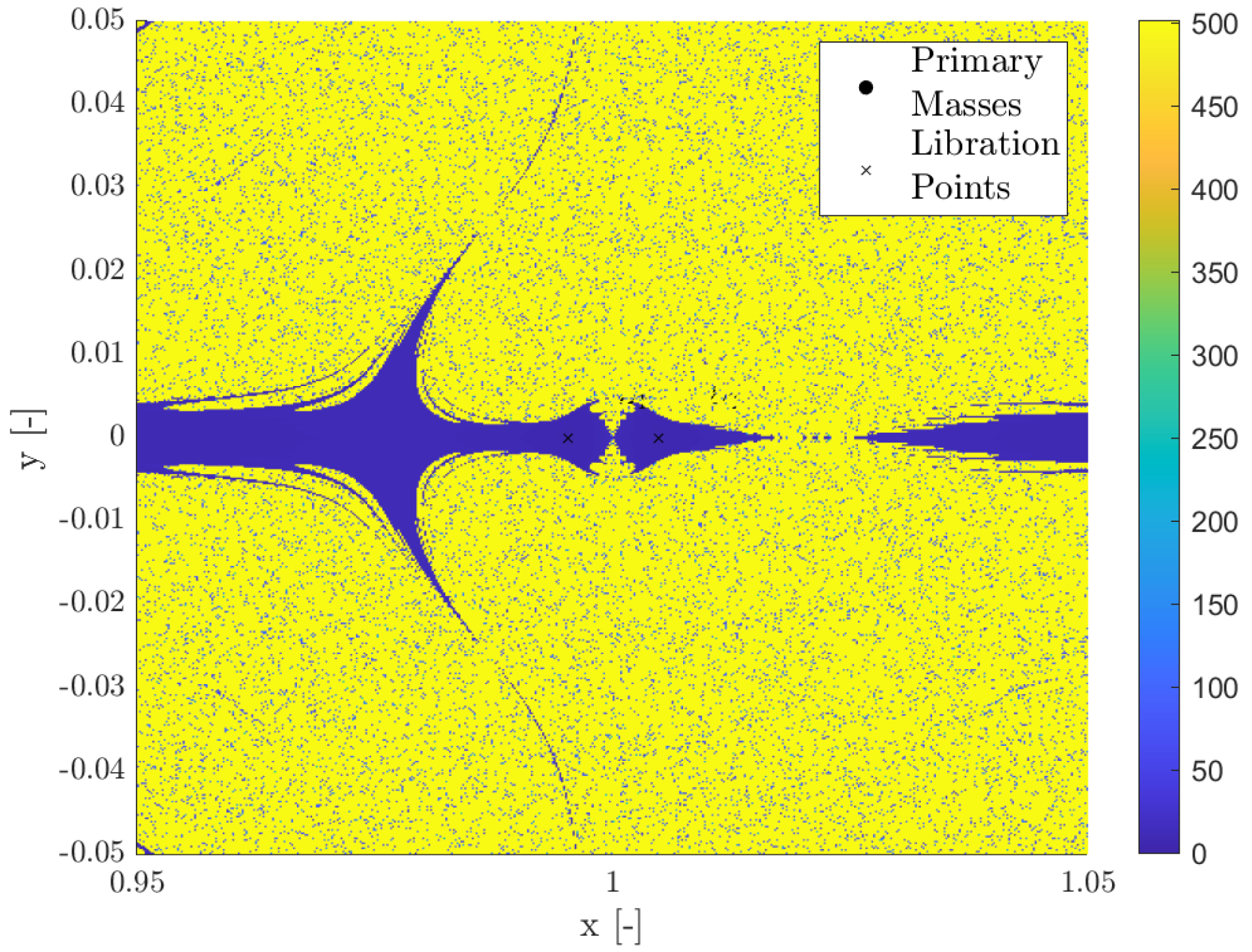Figure 1.
Basins of convergence without radiation forces for the Sun–Earth system (, , and ).
Figure 1.
Basins of convergence without radiation forces for the Sun–Earth system (, , and ).
Figure 2.
Basins of convergence for the Sun–Earth system obtained for , , , and .
Figure 2.
Basins of convergence for the Sun–Earth system obtained for , , , and .
Figure 3.
Basins of convergence for the Sun–Earth system obtained for , , , and .
Figure 3.
Basins of convergence for the Sun–Earth system obtained for , , , and .
Figure 4.
Basins of convergence for the Sun–Earth system considering the effects of oblateness with , , , and .
Figure 4.
Basins of convergence for the Sun–Earth system considering the effects of oblateness with , , , and .
Figure 5.
Basins of convergence for the Sun–Earth system considering the effects of oblateness with , , , and .
Figure 5.
Basins of convergence for the Sun–Earth system considering the effects of oblateness with , , , and .
Figure 6.
Basins of convergence for the Sun–Earth system considering relativistic effects with , , and .
Figure 6.
Basins of convergence for the Sun–Earth system considering relativistic effects with , , and .
Figure 7.
Basins of convergence for the Sun–Earth system considering relativistic effects with , , and .
Figure 7.
Basins of convergence for the Sun–Earth system considering relativistic effects with , , and .
Figure 8.
Basins of convergence for the Sun–Mars system in the classical formulation and for a broad size domain.
Figure 8.
Basins of convergence for the Sun–Mars system in the classical formulation and for a broad size domain.
Figure 9.
Basins of convergence for the Sun–Mars system in the classical formulation and for a reduced size domain.
Figure 9.
Basins of convergence for the Sun–Mars system in the classical formulation and for a reduced size domain.
Figure 10.
Basins of convergence for the Sun–Mars system in the classical formulation, zooming in on Mars.
Figure 10.
Basins of convergence for the Sun–Mars system in the classical formulation, zooming in on Mars.
Figure 11.
Basins of convergence for the Sun–Mars system considering triaxiality effects and a broad size domain.
Figure 11.
Basins of convergence for the Sun–Mars system considering triaxiality effects and a broad size domain.
Figure 12.
Basins of convergence for the Sun–Mars system considering triaxiality effects and a reduced size domain.
Figure 12.
Basins of convergence for the Sun–Mars system considering triaxiality effects and a reduced size domain.
Figure 13.
Basins of convergence for the Sun–Mars system considering triaxiality effects, zooming in on Mars.
Figure 13.
Basins of convergence for the Sun–Mars system considering triaxiality effects, zooming in on Mars.
Figure 14.
Basins of convergence for the Sun–Mars system considering triaxiality and radiation effects for a broad size domain.
Figure 14.
Basins of convergence for the Sun–Mars system considering triaxiality and radiation effects for a broad size domain.
Figure 15.
Basins of convergence for the Sun–Mars system considering triaxiality and radiation effects for a reduced size domain.
Figure 15.
Basins of convergence for the Sun–Mars system considering triaxiality and radiation effects for a reduced size domain.
Figure 16.
Basins of convergence for the Sun–Mars system considering triaxiality and radiation effects, zooming in on Mars.
Figure 16.
Basins of convergence for the Sun–Mars system considering triaxiality and radiation effects, zooming in on Mars.
Figure 17.
Iterations needed until convergence for the Sun–Mars system when triaxiality effects are included [broad domain].
Figure 17.
Iterations needed until convergence for the Sun–Mars system when triaxiality effects are included [broad domain].
Figure 18.
Iterations needed until convergence for the Sun–Mars system when triaxiality effects are included [reduced domain].
Figure 18.
Iterations needed until convergence for the Sun–Mars system when triaxiality effects are included [reduced domain].
Figure 19.
Iterations needed until convergence for the Sun–Mars system when triaxiality effects are included [zooming in on Mars].
Figure 19.
Iterations needed until convergence for the Sun–Mars system when triaxiality effects are included [zooming in on Mars].
Table 1.
Libration point coordinates for the Sun–Earth system without radiation forces, that is, for , , and .
Table 1.
Libration point coordinates for the Sun–Earth system without radiation forces, that is, for , , and .
| Libration Points | Coordinates |
|---|
| (0.75280529, 0) |
| (1.67007870, 0) |
| (−1.60407046, 0) |
| (0.44999999, 1.50659952) |
| (0.44999999, −1.50659952) |
Table 2.
Libration point coordinates for the Sun–Earth system obtained for , , , and .
Table 2.
Libration point coordinates for the Sun–Earth system obtained for , , , and .
| Libration Points | Coordinates |
|---|
| (−0.06229089, 0) |
| (1.68242540, 0) |
| (−1.5540698, 0) |
| (−0.36364010, 1.33190385) |
| (−0.36364010, −1.33190385) |
Table 3.
Libration point coordinates for the Sun–Earth system obtained for , , , and .
Table 3.
Libration point coordinates for the Sun–Earth system obtained for , , , and .
| Libration Points | Coordinates |
|---|
| (−0.04943902, 0) |
| (0.90150065, 0) |
| (−0.83200116, 0) |
| (−0.06132351, 0.33144656) |
| (−0.06132351, −0.33144656) |
Table 4.
Libration point coordinates for the Sun–Earth system considering the effects of oblateness with , , , and .
Table 4.
Libration point coordinates for the Sun–Earth system considering the effects of oblateness with , , , and .
| Libration Points | Coordinates |
|---|
| (0.70490520, 0) |
| (1.14837969, 0) |
| (−1.0544736, 0) |
| (0.06123130, 0.85300535) |
| (0.06123130, −0.85300535) |
Table 5.
Libration point coordinates for the Sun–Earth system considering the effects of oblateness with , , , and .
Table 5.
Libration point coordinates for the Sun–Earth system considering the effects of oblateness with , , , and .
| Libration Points | Coordinates |
|---|
| (0.66297092, 0) |
| (1.20457368, 0) |
| (−1.0496936, 0) |
| (0.79265246, 0.57347612) |
| (0.79265246, −0.57347612) |
| (−0.4440806, 1.02755166) |
| (−0.4440806, −1.02755166) |
Table 6.
Libration point coordinates for the Sun–Earth system considering relativistic effects with , , and .
Table 6.
Libration point coordinates for the Sun–Earth system considering relativistic effects with , , and .
| Libration Points | Coordinates |
|---|
| (0, 0) |
| (1.19840614, 0) |
| (−1.19840614, 0) |
| (0, 0.86602540) |
| (0, −0.86602540) |
Table 7.
Libration point coordinates for the Sun–Earth system considering relativistic effects with , , and .
Table 7.
Libration point coordinates for the Sun–Earth system considering relativistic effects with , , and .
| Libration Points | Coordinates |
|---|
| (−0.21134724, 0) |
| (1.27677761, 0) |
| (−0.90827430, 0) |
| (−0.30157487, 0.59789441) |
| (−0.30157487, −0.59789441) |
Table 8.
Sun–Mars problem data [
31,
32].
Table 8.
Sun–Mars problem data [
31,
32].
| Parameter | Value |
|---|
| Mass of Sun [kg] | |
| Mass of Mars [kg] | |
| Sun–Mars distance [km] | |
Table 9.
Coordinates of the Sun–Mars libration points in the classical formulation.
Table 9.
Coordinates of the Sun–Mars libration points in the classical formulation.
| Libration Points | Obtained Coordinates
|
|---|
| (0.99525, 0) |
| (1.00476, 0) |
| (−1.00000, 0) |
| (0.50000, 0.86603) |
| (0.50000, −0.86603) |
Table 10.
Data on the primary masses used for the generation of the BCs. They allow us to calculate the triaxiality parameters using Equation (
10).
Table 10.
Data on the primary masses used for the generation of the BCs. They allow us to calculate the triaxiality parameters using Equation (
10).
| Parameter | Sun [31] | Mars [32] |
|---|
| Ellipticity [-] | 0.00005 | 0.00589 |
| Average volumetric radius [km] | | |
| Equatorial semi-axis [km] | | |
| Polar semi-axis [km] | | |
Table 11.
Coordinates of the Sun–Mars libration points considering triaxiality effects.
Table 11.
Coordinates of the Sun–Mars libration points considering triaxiality effects.
| Libration Points | Obtained Coordinates
|
|---|
| (0.99525, 0) |
| (1.00476, 0) |
| (d1.00000, 0) |
| (0.50000, 0.86603) |
| (0.50000, −0.86603) |
Table 12.
Mars satellite data: Phobos and Deimos.
Table 12.
Mars satellite data: Phobos and Deimos.
| Parameter | Phobos [33] | Deimos [34] |
|---|
| Mass [kg] | | |
| Major axis of the orbit [km] | | |
| Orbital period [H] | 7.65 | 30.00 |
| Average movement (approximate) [1/s] | | |
Table 13.
Coordinates of the Sun–Mars libration points considering triaxiality and radiation effects.
Table 13.
Coordinates of the Sun–Mars libration points considering triaxiality and radiation effects.
| Libration Points | Obtained Coordinates
|
|---|
| (0.73680, 0) |
| (−0.73681, 0) |
| (0.27144, 0.68498) |
| (0.27144, −0.68498) |
